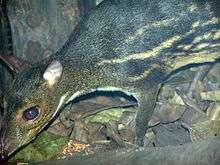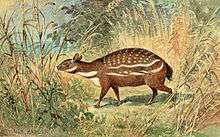Chevrotain
| Chevrotains Temporal range: Oligocene–Recent | |
|---|---|
| | |
| Tragulus kanchil | |
| Scientific classification | |
| Kingdom: | Animalia |
| Phylum: | Chordata |
| Clade: | Synapsida |
| Class: | Mammalia |
| Order: | Artiodactyla |
| Infraorder: | Tragulina |
| Family: | Tragulidae Milne-Edwards, 1864 |
| Genera | |
Chevrotains, also known as mouse-deer, are small ungulates that make up the family Tragulidae, the only members of the infraorder Tragulina. The ten extant species are in three genera,[1][2] but several species also are known only from fossils.[3] The extant species are found in forests in South and Southeast Asia, with a single species in the rainforests of Central and West Africa.[4] They are solitary or live in pairs, and feed almost exclusively on plant material.[4] Depending on exact species, the Asian species weigh between 0.7 and 8.0 kg (1.5 and 17.6 lb), and include the smallest ungulates in the world.[4] The African chevrotain is considerably larger at 7–16 kg (15–35 lb).[5]
Etymology
Chevrotain is a French word that means "little goat".
The single African species is consistently known as "chevrotain".[1][4][6] The names "chevrotain" and "mouse-deer" have been used interchangeably among the Asian species,[4][7][8][9] though recent authorities typically have preferred chevrotain for the species in the genus Moschiola and mouse-deer for the species in the genus Tragulus.[1] Consequently, all species with pale-spotted or -striped upper parts are known as "chevrotain" and without are known as "mouse-deer".
The Telugu name for the Indian spotted chevrotain is jarini pandi, which literally means "a deer and a pig". In Kannada, it is called barka (ಬರ್ಕ), in Malayalam, it is called khooran, and the Konkani name for it is barinka. The Tamil term is சருகு மான் sarukumāṉ "leaf-pile deer".
The Sinhalese name meeminna roughly translates to "mouse-like deer". This was used in the scientific name of the Sri Lankan spotted chevrotain, M. meminna.
Biology
The family is widespread and successful from the Oligocene (34 million years ago) through the Miocene (about 5 million years ago), but has remained almost unchanged over that time and remains as an example of primitive ruminant form. They have four-chambered stomachs to ferment tough plant foods, but the third chamber is poorly developed. Though most species feed exclusively on plant material, the water chevrotain occasionally takes insects and crabs, or scavenges meat and fish.[10] Like other ruminants, they lack upper incisors. They give birth to only a single young.
In other respects, however, they have primitive features, closer to nonruminants such as pigs. All species in the family lack antlers and horns, but both sexes have elongated canine teeth. These are especially prominent in males, where they project out on either side of the lower jaw, and are used in fights.[4] Their legs are short and thin, which leave them lacking in agility, but also helps to maintain a smaller profile to aid in running through the dense foliage of their environments. Other pig-like features include the presence of four toes on each foot, the absence of facial scent glands, premolars with sharp crowns, and the form of their sexual behaviour and copulation.[11]
They are solitary or live in pairs.[4] The young are weaned at three months of age, and reach sexual maturity between five and 10 months, depending on species. Parental care is relatively limited. Although they lack the types of scent glands found in most other ruminants, they do possess a chin gland for marking each other as mates or antagonists, and, in the case of the water chevrotain, anal and preputial glands for marking territory. Their territories are relatively small, on the order of 13–24 hectares (32–59 acres), but neighbors generally ignore each other, rather than compete aggressively.[11]
Some of the species show a remarkable affinity with water, often remaining submerged for prolonged periods to evade predators or other unwelcome intrusion. This has also lent support to the idea that whales evolved from water-loving creatures that looked like small deer.[12][13]
Taxonomy
Traditionally, only four extant species were recognized in the family Tragulidae.[4] In 2004, T. nigricans and T. versicolor were split from T. napu, and T. kanchil, and T. williamsoni was split from T. javanicus.[14] In 2005, M. indica and M. kathygre were split from M. meminna.[2] With these changes, the 10 extant species are:

- Family Tragulidae
- Genus Hyemoschus
- Water chevrotain, Hyemoschus aquaticus
- Genus Moschiola
- Indian spotted chevrotain, Moschiola indica
- Sri Lankan spotted chevrotain, Moschiola meminna
- Yellow-striped chevrotain, Moschiola kathygre
- Genus Tragulus
- Java mouse-deer, Tragulus javanicus
- Lesser mouse-deer or kanchil, Tragulus kanchil
- Greater mouse-deer, Tragulus napu
- Philippine mouse-deer, Tragulus nigricans
- Vietnam mouse-deer, Tragulus versicolor
- Williamson's mouse-deer, Tragulus williamsoni
- Genus Hyemoschus
Ancient chevrotains

The six extinct chevrotains genera[3] include:
- Genus Dorcatherium
- Dorcatherium minus from Pakistan
- Dorcatherium majus from Pakistan
- Dorcatherium nani, kaup, from Central Europe[15]
- Genus Dorcabune
- Genus Afrotragulus Sánchez, Quiralte, Morales and Pickford, 2010 [16]
- Afrotragulus moruorotensis (previously "Dorcatherium" moruorotensis Pickford, 2001) (early Miocene) from Moruorot, Kenya
- Afrotragulus parvus (previously "D." parvus Withworth 1958) (early Miocene) from Rusinga Island, Kenya
- Genus Siamotragulus
- Genus Yunnanotherium
- Genus Archaeotragulus[17]
- Genus Krabitherium
The Hypertragulidae were closely related to the Tragulidae.
References
- 1 2 3 Wilson, D.E.; Reeder, D.M., eds. (2005). Mammal Species of the World: A Taxonomic and Geographic Reference (3rd ed.). Johns Hopkins University Press. ISBN 978-0-8018-8221-0. OCLC 62265494.
- 1 2 Groves, C., and E. Meijaard (2005). Intraspecific variation in Moschiola, the Indian Chevrotain. The Raffles Bulletin of Zoology. Supplement 12: 413–421
- 1 2 Farooq, U., Khan, M.A., Akhtar, M. and Khan, A.M. 2008. Lower dentition of Dorcatherium majus (Tragulidae, Mammalia) in the Lower and Middle Siwaliks (Miocene) of Pakistan Archived September 28, 2011, at the Wayback Machine.. Tur. J. Zool., 32: 91–98.
- 1 2 3 4 5 6 7 8 Nowak, R. M. (eds) (1999). Walker's Mammals of the World. 6th edition. Johns Hopkins University Press.
- ↑ UltimateUngulate: Hyemoschus aquaticus. Accessed 12 October 2010.
- ↑ IUCN SSC Antelope Specialist Group (2008). "Hyemoschus aquaticus". IUCN Red List of Threatened Species. Version 2008. International Union for Conservation of Nature. Retrieved 12 October 2010.
- ↑ IUCN SSC Antelope Specialist Group (2008). "Moschiola indica". IUCN Red List of Threatened Species. Version 2008. International Union for Conservation of Nature. Retrieved 12 October 2010.
- ↑ IUCN SSC Antelope Specialist Group (2008). "Moschiola kathygre". IUCN Red List of Threatened Species. Version 2008. International Union for Conservation of Nature. Retrieved 12 October 2010.
- ↑ IUCN SSC Antelope Specialist Group (2008). "Moschiola meminna". IUCN Red List of Threatened Species. Version 2008. International Union for Conservation of Nature. Retrieved 12 October 2010.
- ↑ Kingdon, J. (1997). The Kingdon Field Guide to African Mammals. Academic Press. ISBN 0-12-408355-2
- 1 2 Dubost, G. (1984). Macdonald, D., ed. The Encyclopedia of Mammals. New York: Facts on File. pp. 516–517. ISBN 0-87196-871-1.
- ↑ Walker, M. (2009-07-07). "Aquatic deer and ancient whales". BBC News. Retrieved 2010-03-26.
- ↑ Meijaard, E.; Umilaela; de Silva Wijeyeratne, G. (September 2010). "Aquatic escape behaviour in mouse-deer provides insight into tragulid evolution". Mammalian Biology. 75 (5): 471–473. doi:10.1016/j.mambio.2009.05.007. Retrieved 2016-04-12.
- ↑ Meijaard, I., and C. P. Groves (2004). A taxonomic revision of the Tragulus mouse-deer. Zoological Journal of the Linnean Society 140: 63–102.
- ↑ E. Thenius 1950. Über die Sichtung und Bearbeitung der jungtertiären Säugetierreste aus dem Hausruck und Kobernaußerwald (O.Ö.) in Verh. Geol. B.-A. 51/2, pp 56
- ↑ Israel M. Sánchez; Victoria Quiralte; Jorge Morales; Martin Pickford (2010). "A new genus of tragulid ruminant from the early Miocene of Kenya" (PDF). Acta Palaeontologica Polonica. 55 (2): 177–187. doi:10.4202/app.2009.0087.
- ↑ Métais, G.; Chaimanee, Y.; Jaeger, J.-J. & Ducrocq S (2001). "New remains of primitive ruminants from Thailand: Evidence of the early evolution of the Ruminantia in Asia" (PDF). Zoologica Scripta. 30 (4): 231. doi:10.1046/j.0300-3256.2001.00071.x.
- ↑ Terry A. Vaughan; James M. Ryan; Nicholas J. Czaplewski (2011-04-21). Mammalogy (5th ed.). ISBN 9780-7637-6299-5. Retrieved April 4, 2012.
- ↑ Sánchez, Israel M.; Quiralte, Victoria; Morales, Jorge; Pickford, Martin (2010). "A New Genus of Tragulid Ruminant from the Early Miocene of Kenya". Acta Palaeontologica Polonica. 55 (2): 177. doi:10.4202/app.2009.0087.
- ↑ Paleobiology Database: Krabitherium. Paleodb.org. Retrieved on 2013-01-18.
External links
-
 Lydekker, Richard (1911). "Chevrotain". Encyclopædia Britannica (11th ed.).
Lydekker, Richard (1911). "Chevrotain". Encyclopædia Britannica (11th ed.).